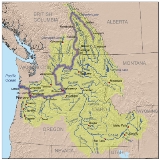
Fort Nez Percés
Encyclopedia
Fort Nez Percés, sometimes also spelled Fort Nez Percé (with or without the accent), named after the Nez Perce people and later known as (Old) Fort Walla Walla, was a fortified British fur trading
post on the Columbia River
on the territory of modern-day Wallula, Washington
. It was in operation from 1818 until 1857.
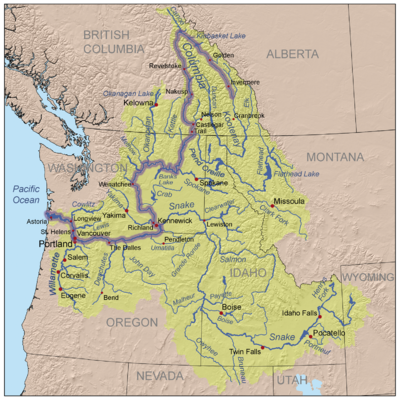
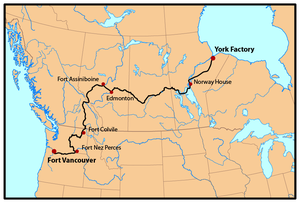 During David Thompson
During David Thompson
's 1811 voyage down the Columbia River he camped at the junction with the Snake River
on July 9, 1811, and erected a pole and a notice claiming the country for Great Britain
and stating the intention of the North West Company
to build a trading post at the site.
. They constructed the fort on the east bank of the Columbia River
, half a mile north of the mouth of the Walla Walla River
and a few miles below the mouth of the Snake River
.
The location was chosen for its strategic geographic value. The nearby Walla Walla Valley had long been an important rendezvous point for parties working several peripheral fur districts. The 1815 decision to refocus the entire New Caledonia
region southward to the Columbia River meant greatly increased traffic on the river. Furthermore, Donald MacKenzie intended to open up the Snake River
country, adding another operation converging on the area where Fort Nez Percés was built. Essentially all company exports and supplies passed through the Columbia Gorge. The location of Fort Nez Percés at the eastern end of this trunk line to the ocean made it the most important post in the interior. In addition, increasing tensions from occupying the homelands of the local Native American
s necessitated a permanent fortified post. Finally, the area was significant to the Indians themselves. Not only was it a major meeting and trading ground, but it was where Lewis and Clark
had first met the Columbia River indigenous peoples and had made an informal treaty
of friendship.
Ross became the first chief factor of the fort. Fort Nez Percés was an important post on the York Factory Express
trade route route to London
via Hudson Bay
.
, unique among North West Company forts. The inner wall was 12 feet (3.7 m) high and made of sawed timber. The storehouse and dwellings were within. Trade was conducted via a small hole in the inner wall. The outer palisade was made of planks 20 feet (6.1 m) high and 6 inches (152.4 mm) thick, and topped with a range of balustrades. There were four towers at each of the fort's corners, and these each contained large water tanks for fighting fire. Soon after it was built, Alexander Ross
said it was "the strongest and most complete fort west of the Rocky Mountains, and might be called the Gibraltar of the Columbia."
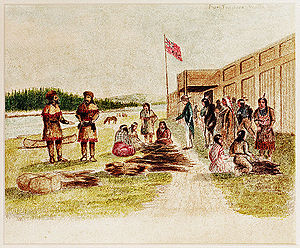
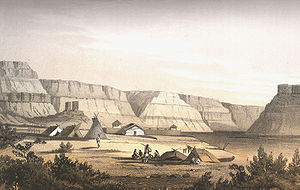
 In 1821, the escalating conflicts between the competing North West Company and the Hudson's Bay Company
In 1821, the escalating conflicts between the competing North West Company and the Hudson's Bay Company
resulted in a forced merger of the two. The Hudson's Bay Company took over all the North West Company's operations, and administered them as the Columbia District
. Fort Nez Percés remained an important HBC fur trade post and base for beaver
hunting expeditions, as well as an important stop on the twice annual York Factory Express
trade route to London
via Hudson Bay
.
Shortly after a visit by the American Charles Wilkes
' expedition
(which lost one of two ships on Columbai River bar); the fort was destroyed by fire on October 5, 1841. It was subsequently rebuilt out of adobe
bricks.
The HBC's Sinclair
settlement expedition from the Red River Colony
passed through in 1841, one day before the fire. They helped save what they could, but they decided not to stay. Rather they traveled through the night because the large number of Indians in the area made it unsafe to camp.
The Fort, along with other HBC forts on the western end of the Oregon Trail
route, including Fort Vancouver
near its terminus in the Willamette Valley
; all gave substantial and often desperately needed aid to the early American Oregon Trail pioneers.
, which ended the Oregon boundary dispute
with Britain. The British lost the lands north of the Columbia River they had long controlled. The new border was established much further north at the 49th parallel
. The treaty did allow Hudson's Bay Company navigation rights on the Columbia River to supply their fur posts, and clear titles to their trading post properties allowing them to be sold later if they wanted. HBC continued to operate the Fort Nez Perces for another decade. It was again burnt down at the beginning of the Yakima War
in 1855. James Sinclair
was among the casualties of the battle. The fort was rebuilt a second time, but was eventually abandoned in 1857 when the Hudson's Bay Company gave up its declining business in the then fully American Oregon Territory
and relocated its headquarters in the Northwest from Fort Vancouver
to Fort Victoria
, in present day British Columbia
.
in 1858 at nearby Walla Walla, Washington
.
Fur trade
The fur trade is a worldwide industry dealing in the acquisition and sale of animal fur. Since the establishment of world market for in the early modern period furs of boreal, polar and cold temperate mammalian animals have been the most valued...
post on the Columbia River
Columbia River
The Columbia River is the largest river in the Pacific Northwest region of North America. The river rises in the Rocky Mountains of British Columbia, Canada, flows northwest and then south into the U.S. state of Washington, then turns west to form most of the border between Washington and the state...
on the territory of modern-day Wallula, Washington
Wallula, Washington
Wallula is a census-designated place in Walla Walla County, Washington, United States. The population was 179 at the 2010 census.-History:Lewis and Clark reached the area April 27, 1806, on their return journey from the Pacific...
. It was in operation from 1818 until 1857.
North West Company


David Thompson (explorer)
David Thompson was an English-Canadian fur trader, surveyor, and map-maker, known to some native peoples as "Koo-Koo-Sint" or "the Stargazer"...
's 1811 voyage down the Columbia River he camped at the junction with the Snake River
Snake River
The Snake is a major river of the greater Pacific Northwest in the United States. At long, it is the largest tributary of the Columbia River, the largest North American river that empties into the Pacific Ocean...
on July 9, 1811, and erected a pole and a notice claiming the country for Great Britain
Great Britain
Great Britain or Britain is an island situated to the northwest of Continental Europe. It is the ninth largest island in the world, and the largest European island, as well as the largest of the British Isles...
and stating the intention of the North West Company
North West Company
The North West Company was a fur trading business headquartered in Montreal from 1779 to 1821. It competed with increasing success against the Hudson's Bay Company in what was to become Western Canada...
to build a trading post at the site.
Location
The fort was founded several years later, in July 1818 by the North West Company under the direction of traders Donald MacKenzie and Alexander RossAlexander Ross (fur trader)
-Fur trader and explorer:Ross emigrated to Upper Canada, present day , from Scotland about 1805.In 1811, while working for John Jacob Astor's Pacific Fur Company, Ross took part in the founding of Fort Astoria, a fur-trading post at the mouth of the Columbia River...
. They constructed the fort on the east bank of the Columbia River
Columbia River
The Columbia River is the largest river in the Pacific Northwest region of North America. The river rises in the Rocky Mountains of British Columbia, Canada, flows northwest and then south into the U.S. state of Washington, then turns west to form most of the border between Washington and the state...
, half a mile north of the mouth of the Walla Walla River
Walla Walla River
The Walla Walla River is a tributary of the Columbia River, joining the Columbia just above Wallula Gap in southeastern Washington in the United States. The river flows through Umatilla County, Oregon and Walla Walla County, Washington. Its drainage basin is in area.-Course:The headwaters of the...
and a few miles below the mouth of the Snake River
Snake River
The Snake is a major river of the greater Pacific Northwest in the United States. At long, it is the largest tributary of the Columbia River, the largest North American river that empties into the Pacific Ocean...
.
The location was chosen for its strategic geographic value. The nearby Walla Walla Valley had long been an important rendezvous point for parties working several peripheral fur districts. The 1815 decision to refocus the entire New Caledonia
New Caledonia (Canada)
New Caledonia was the name given to a district of the Hudson's Bay Company that comprised the territory largely coterminous with the present-day province of British Columbia, Canada. Though not a British colony, New Caledonia was part of the British claim to North America. Its administrative...
region southward to the Columbia River meant greatly increased traffic on the river. Furthermore, Donald MacKenzie intended to open up the Snake River
Snake River
The Snake is a major river of the greater Pacific Northwest in the United States. At long, it is the largest tributary of the Columbia River, the largest North American river that empties into the Pacific Ocean...
country, adding another operation converging on the area where Fort Nez Percés was built. Essentially all company exports and supplies passed through the Columbia Gorge. The location of Fort Nez Percés at the eastern end of this trunk line to the ocean made it the most important post in the interior. In addition, increasing tensions from occupying the homelands of the local Native American
Native Americans in the United States
Native Americans in the United States are the indigenous peoples in North America within the boundaries of the present-day continental United States, parts of Alaska, and the island state of Hawaii. They are composed of numerous, distinct tribes, states, and ethnic groups, many of which survive as...
s necessitated a permanent fortified post. Finally, the area was significant to the Indians themselves. Not only was it a major meeting and trading ground, but it was where Lewis and Clark
Lewis and Clark Expedition
The Lewis and Clark Expedition, or ″Corps of Discovery Expedition" was the first transcontinental expedition to the Pacific Coast by the United States. Commissioned by President Thomas Jefferson and led by two Virginia-born veterans of Indian wars in the Ohio Valley, Meriwether Lewis and William...
had first met the Columbia River indigenous peoples and had made an informal treaty
Treaty
A treaty is an express agreement under international law entered into by actors in international law, namely sovereign states and international organizations. A treaty may also be known as an agreement, protocol, covenant, convention or exchange of letters, among other terms...
of friendship.
Ross became the first chief factor of the fort. Fort Nez Percés was an important post on the York Factory Express
York Factory Express
The York Factory Express, usually called "the Express" and also called the Columbia Express and the Communication, was a brigade operated by Hudson's Bay Company in the early 19th century connecting York Factory and Fort Vancouver. It was named "express" because it was not used only to transport...
trade route route to London
London
London is the capital city of :England and the :United Kingdom, the largest metropolitan area in the United Kingdom, and the largest urban zone in the European Union by most measures. Located on the River Thames, London has been a major settlement for two millennia, its history going back to its...
via Hudson Bay
Hudson Bay
Hudson Bay , sometimes called Hudson's Bay, is a large body of saltwater in northeastern Canada. It drains a very large area, about , that includes parts of Ontario, Quebec, Saskatchewan, Alberta, most of Manitoba, southeastern Nunavut, as well as parts of North Dakota, South Dakota, Minnesota,...
.
Fort description
The fort was built with a double palisadePalisade
A palisade is a steel or wooden fence or wall of variable height, usually used as a defensive structure.- Typical construction :Typical construction consisted of small or mid sized tree trunks aligned vertically, with no spacing in between. The trunks were sharpened or pointed at the top, and were...
, unique among North West Company forts. The inner wall was 12 feet (3.7 m) high and made of sawed timber. The storehouse and dwellings were within. Trade was conducted via a small hole in the inner wall. The outer palisade was made of planks 20 feet (6.1 m) high and 6 inches (152.4 mm) thick, and topped with a range of balustrades. There were four towers at each of the fort's corners, and these each contained large water tanks for fighting fire. Soon after it was built, Alexander Ross
Alexander Ross (fur trader)
-Fur trader and explorer:Ross emigrated to Upper Canada, present day , from Scotland about 1805.In 1811, while working for John Jacob Astor's Pacific Fur Company, Ross took part in the founding of Fort Astoria, a fur-trading post at the mouth of the Columbia River...
said it was "the strongest and most complete fort west of the Rocky Mountains, and might be called the Gibraltar of the Columbia."
Snake River expeditions
In September 1818 Donald MacKenzie left his new base at Fort Nez Percés to lead a large fur trapping party into the Snake River country. The operation was a major departure from the usual practice of the North West Company. MacKenzie spent the winter of 1818-19 shifting camps and trapping in a large region. His return to Fort Nez Percés in July 1819 with an unusually large and valuable catch won him praise and vindicated the establishment of Fort Nez Percés, which some company partners had been skeptical. The Snake country expeditions from Fort Nez Percés became an annual affair and regularly produced a large portion of company's entire fur export west of the Rocky Mountains.Hudson's Bay Company merger



Hudson's Bay Company
The Hudson's Bay Company , abbreviated HBC, or "The Bay" is the oldest commercial corporation in North America and one of the oldest in the world. A fur trading business for much of its existence, today Hudson's Bay Company owns and operates retail stores throughout Canada...
resulted in a forced merger of the two. The Hudson's Bay Company took over all the North West Company's operations, and administered them as the Columbia District
Columbia District
The Columbia District was a fur trading district in the Pacific Northwest region of British North America in the 19th century. It was explored by the North West Company between 1793 and 1811, and established as an operating fur district around 1810...
. Fort Nez Percés remained an important HBC fur trade post and base for beaver
Beaver
The beaver is a primarily nocturnal, large, semi-aquatic rodent. Castor includes two extant species, North American Beaver and Eurasian Beaver . Beavers are known for building dams, canals, and lodges . They are the second-largest rodent in the world...
hunting expeditions, as well as an important stop on the twice annual York Factory Express
York Factory Express
The York Factory Express, usually called "the Express" and also called the Columbia Express and the Communication, was a brigade operated by Hudson's Bay Company in the early 19th century connecting York Factory and Fort Vancouver. It was named "express" because it was not used only to transport...
trade route to London
London
London is the capital city of :England and the :United Kingdom, the largest metropolitan area in the United Kingdom, and the largest urban zone in the European Union by most measures. Located on the River Thames, London has been a major settlement for two millennia, its history going back to its...
via Hudson Bay
Hudson Bay
Hudson Bay , sometimes called Hudson's Bay, is a large body of saltwater in northeastern Canada. It drains a very large area, about , that includes parts of Ontario, Quebec, Saskatchewan, Alberta, most of Manitoba, southeastern Nunavut, as well as parts of North Dakota, South Dakota, Minnesota,...
.
Shortly after a visit by the American Charles Wilkes
Charles Wilkes
Charles Wilkes was an American naval officer and explorer. He led the United States Exploring Expedition, 1838-1842 and commanded the ship in the Trent Affair during the American Civil War...
' expedition
United States Exploring Expedition
The United States Exploring Expedition was an exploring and surveying expedition of the Pacific Ocean and surrounding lands conducted by the United States from 1838 to 1842. The original appointed commanding officer was Commodore Thomas ap Catesby Jones. The voyage was authorized by Congress in...
(which lost one of two ships on Columbai River bar); the fort was destroyed by fire on October 5, 1841. It was subsequently rebuilt out of adobe
Adobe
Adobe is a natural building material made from sand, clay, water, and some kind of fibrous or organic material , which the builders shape into bricks using frames and dry in the sun. Adobe buildings are similar to cob and mudbrick buildings. Adobe structures are extremely durable, and account for...
bricks.
The HBC's Sinclair
James Sinclair (fur trapper)
James Sinclair was a trader and explorer with the Hudson's Bay Company. He was the son of Hudson's Bay Company factor William Sinclair, from Eastaquoy in Harray, and his Cree wife, Nahovway. He was a brother of William Sinclair. James was born in Rupert's Land and educated in Scotland at Edinburgh...
settlement expedition from the Red River Colony
Red River Colony
The Red River Colony was a colonization project set up by Thomas Douglas, 5th Earl of Selkirk in 1811 on of land granted to him by the Hudson's Bay Company under what is referred to as the Selkirk Concession. The colony along the Red River of the North was never very successful...
passed through in 1841, one day before the fire. They helped save what they could, but they decided not to stay. Rather they traveled through the night because the large number of Indians in the area made it unsafe to camp.
The Fort, along with other HBC forts on the western end of the Oregon Trail
Oregon Trail
The Oregon Trail is a historic east-west wagon route that connected the Missouri River to valleys in Oregon and locations in between.After 1840 steam-powered riverboats and steamboats traversing up and down the Ohio, Mississippi and Missouri rivers sped settlement and development in the flat...
route, including Fort Vancouver
Fort Vancouver
Fort Vancouver was a 19th century fur trading outpost along the Columbia River that served as the headquarters of the Hudson's Bay Company in the company's Columbia District...
near its terminus in the Willamette Valley
Willamette Valley
The Willamette Valley is the most populated region in the state of Oregon of the United States. Located in the state's northwest, the region is surrounded by tall mountain ranges to the east, west and south and the valley's floor is broad, flat and fertile because of Ice Age conditions...
; all gave substantial and often desperately needed aid to the early American Oregon Trail pioneers.
United States
The fort found itself on U.S. soil in 1846 as a result of the Oregon TreatyOregon Treaty
The Oregon Treaty is a treaty between the United Kingdom and the United States that was signed on June 15, 1846, in Washington, D.C. The treaty brought an end to the Oregon boundary dispute by settling competing American and British claims to the Oregon Country, which had been jointly occupied by...
, which ended the Oregon boundary dispute
Oregon boundary dispute
The Oregon boundary dispute, or the Oregon Question, arose as a result of competing British and American claims to the Pacific Northwest of North America in the first half of the 19th century. Both the United Kingdom and the United States had territorial and commercial aspirations in the region...
with Britain. The British lost the lands north of the Columbia River they had long controlled. The new border was established much further north at the 49th parallel
49th parallel north
The 49th parallel north is a circle of latitude that is 49 degrees north of the Earth's equatorial plane. It crosses Europe, Asia, the Pacific Ocean, North America, and the Atlantic Ocean....
. The treaty did allow Hudson's Bay Company navigation rights on the Columbia River to supply their fur posts, and clear titles to their trading post properties allowing them to be sold later if they wanted. HBC continued to operate the Fort Nez Perces for another decade. It was again burnt down at the beginning of the Yakima War
Yakima War
The Yakima War was a conflict between the United States and the Yakama, a Sahaptian-speaking people on the Northwest Plateau, then Washington Territory and now the southern interior of Eastern Washington, from 1855 to 1858.- Naming :...
in 1855. James Sinclair
James Sinclair (fur trapper)
James Sinclair was a trader and explorer with the Hudson's Bay Company. He was the son of Hudson's Bay Company factor William Sinclair, from Eastaquoy in Harray, and his Cree wife, Nahovway. He was a brother of William Sinclair. James was born in Rupert's Land and educated in Scotland at Edinburgh...
was among the casualties of the battle. The fort was rebuilt a second time, but was eventually abandoned in 1857 when the Hudson's Bay Company gave up its declining business in the then fully American Oregon Territory
Oregon Territory
The Territory of Oregon was an organized incorporated territory of the United States that existed from August 14, 1848, until February 14, 1859, when the southwestern portion of the territory was admitted to the Union as the State of Oregon. Originally claimed by several countries , the region was...
and relocated its headquarters in the Northwest from Fort Vancouver
Fort Vancouver
Fort Vancouver was a 19th century fur trading outpost along the Columbia River that served as the headquarters of the Hudson's Bay Company in the company's Columbia District...
to Fort Victoria
Victoria, British Columbia
Victoria is the capital city of British Columbia, Canada and is located on the southern tip of Vancouver Island off Canada's Pacific coast. The city has a population of about 78,000 within the metropolitan area of Greater Victoria, which has a population of 360,063, the 15th most populous Canadian...
, in present day British Columbia
British Columbia
British Columbia is the westernmost of Canada's provinces and is known for its natural beauty, as reflected in its Latin motto, Splendor sine occasu . Its name was chosen by Queen Victoria in 1858...
.
U.S. Fort Walla Walla
The U.S. military erected a new Fort Walla WallaFort Walla Walla
Fort Walla Walla is a fort located in Walla Walla, Washington. It was established in 1858. Today, the complex contains a park, a museum, and a hospital.Fort Walla Walla should be distinguished from Fort Nez Percés or Old Fort Walla Walla ....
in 1858 at nearby Walla Walla, Washington
Walla Walla, Washington
Walla Walla is the largest city in and the county seat of Walla Walla County, Washington, United States. The population was 31,731 at the 2010 census...
.
Further reading
- Stern, Th.: Chiefs and Chief Traders: Indian Relations at Fort Nez Percés, Oregon State University Press 1993. ISBN 0-870-71368-X.

